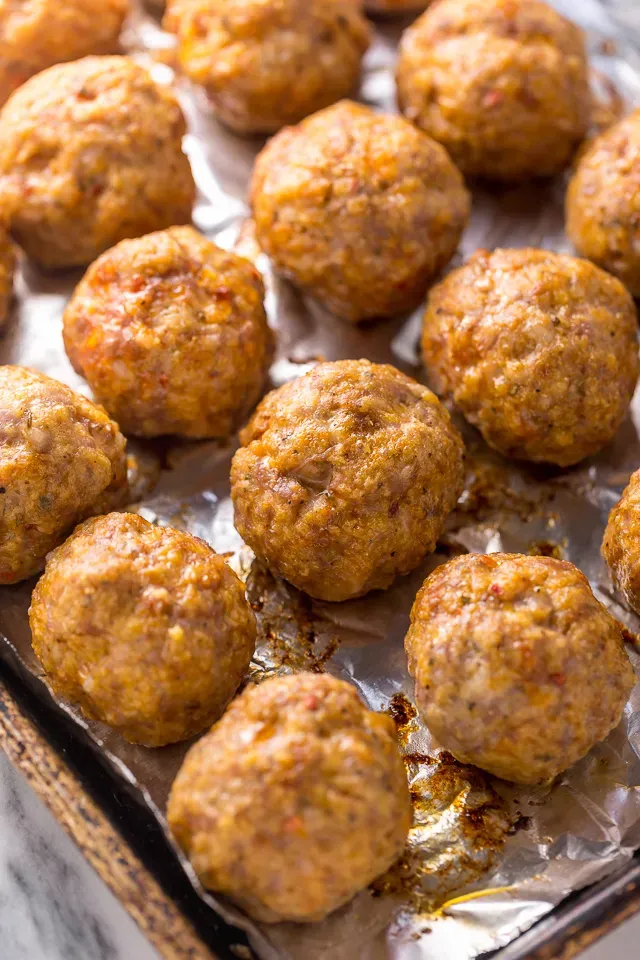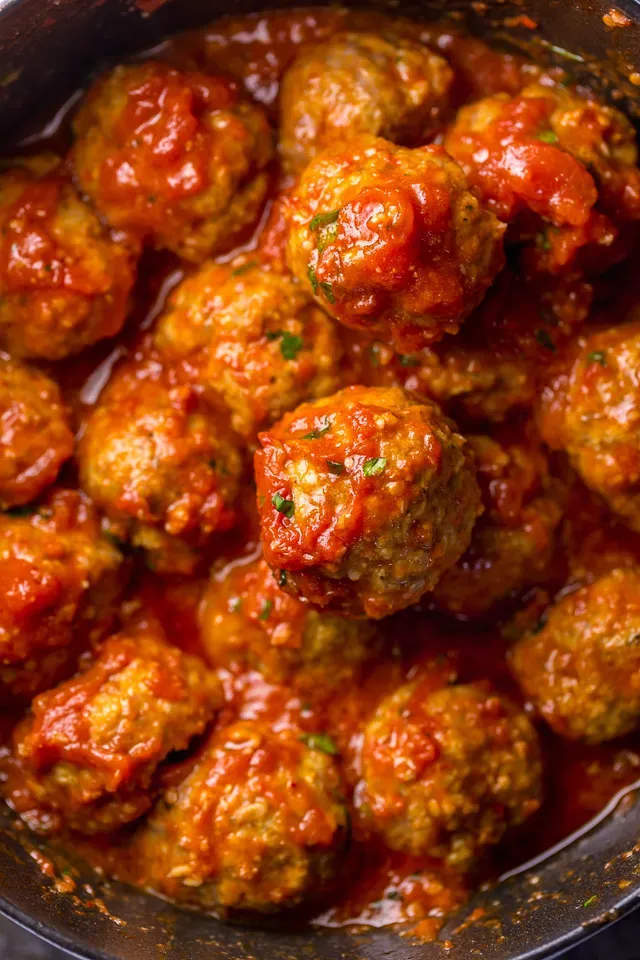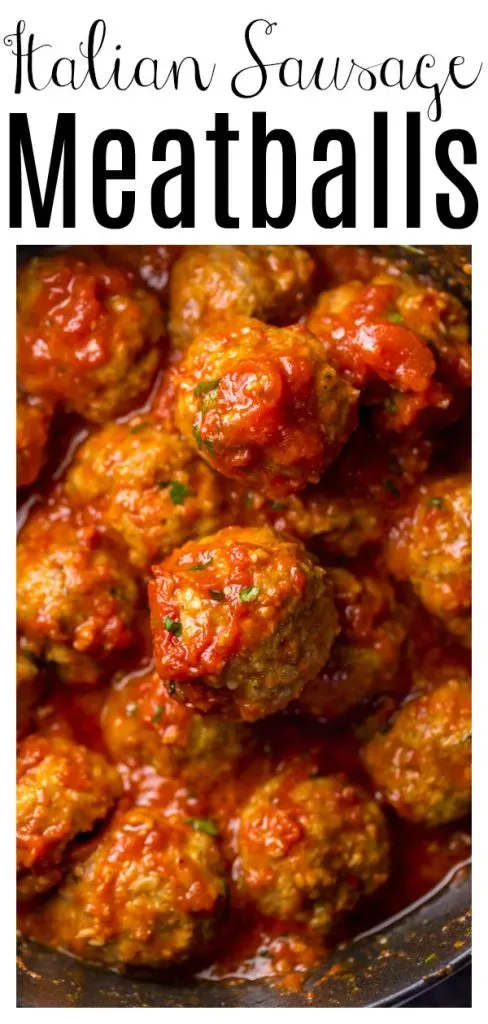Table of Contents
Let's be real: dry, bland meatballs are a culinary crime. You bite in, hoping for that savory burst, and instead get something akin to seasoned sawdust. It's disappointing, and frankly, a waste of good sauce. What if there was a way to guarantee juicy, flavorful meatballs every time without a laundry list of ingredients? This is where the magic of italian sausage meatballs recipes comes in. Forget mixing multiple meats and fussing with a dozen spices. Italian sausage arrives pre-seasoned, packed with flavor from fennel, garlic, and herbs, and often has a higher fat content than lean ground beef, which is your ticket to moisture. Think of it as a head start to deliciousness. In the following sections, we'll dive into why sausage is a game-changer, round up the simple ingredients you'll need, walk through the straightforward steps to cook them, explore ways to serve these beauties beyond just spaghetti, and cover how to keep them tasting great for leftovers. Get ready to ditch the dry disappointment and embrace the ease and flavor of making italian sausage meatballs recipes.
Why Italian Sausage Makes the Best Meatballs

Why Italian Sausage Makes the Best Meatballs
Built-In Flavor Saves the Day
Starting with Italian sausage for your meatballs feels like cheating, honestly, but in the best possible way. This isn't just ground meat; it's a flavor bomb already packed with essentials like fennel seed, garlic, salt, and pepper. Think about starting from scratch with plain ground beef – you're measuring, balancing, hoping you got the ratios right. With sausage, that heavy lifting is already done. The butcher or manufacturer handled the core seasoning, giving you a consistent, robust base that plain meat just can't offer without significant effort. It ensures every single meatball carries that distinct, savory Italian note right from the jump.
Moisture and Tenderness Without the Fuss
Another win for using Italian sausage is the fat content. Leaner meats, while sometimes preferred for health reasons, can result in dry, dense meatballs that feel more like erasers than food. Italian sausage typically contains enough fat to render down during cooking, keeping the meatballs incredibly moist and tender from the inside out. This fat carries flavor compounds and prevents that dreaded dry texture. You don't need to add excessive amounts of milk-soaked bread or extra binders just to keep them from turning into little rocks; the sausage does much of the work itself, leading to a much better mouthfeel.
- Pre-seasoned flavor base
- Higher fat content for moisture
- Consistent taste every time
- Reduces need for extra spices
- Yields tender meatballs
Simplicity is the Ultimate Sophistication
Let's talk about ease. Making italian sausage meatballs recipes drastically simplifies your prep. Instead of needing ground beef, pork, maybe veal, plus a handful of different herbs and spices, you primarily need the sausage. You just squeeze it out of its casing (if it has one), mix in a few basic binding ingredients, and you're ready to roll. This cuts down on grocery list items, prep time, and cleanup. It’s the kind of shortcut that doesn't compromise on the end result, proving that sometimes, the simplest approach delivers the most satisfying outcome.
Gathering Ingredients for Italian Sausage Meatballs

Gathering Ingredients for Italian Sausage Meatballs
Rounding Up Your Meatball Arsenal
Alright, so you're convinced that Italian sausage is the way to go for superior meatballs. Now, let's talk about what else you need to pull this off. Gathering Ingredients for Italian Sausage Meatballs isn't a complex expedition. You'll obviously need the star of the show: Italian sausage. Decide if you want sweet or hot, or maybe a mix, depending on your heat tolerance. Beyond that, you need something to bind everything together and add a little tenderness. This usually means breadcrumbs – plain dry ones work fine, or even fresh bread torn up and soaked briefly. You'll need an egg; it's the glue that holds the party together. Grated cheese, specifically Pecorino Romano, is traditional and punches up the flavor significantly, but Parmesan works too. Fresh parsley chopped up adds a nice bit of color and freshness. And finally, a splash of liquid – water or milk – helps keep things moist and prevents the mixture from being too dense. That's really it. No need for exotic spices or hard-to-find items. Just simple stuff that works.
How to Cook Perfect Italian Sausage Meatballs

How to Cook Perfect Italian Sausage Meatballs
Mixing and Shaping Your Meatballs Just Right
Alright, you've got your ingredients ready. Now comes the hands-on part of How to Cook Perfect Italian Sausage Meatballs: mixing and shaping. This is where some people mess up by getting too aggressive. You want to combine everything until it's just incorporated – the sausage meat, breadcrumbs, cheese, egg, and liquid. Overworking the meat develops the protein too much, leading to tough meatballs. Think of it like mixing biscuit dough; handle it gently. Use your hands; it’s the best tool here to feel when everything is combined but not overworked. Once mixed, it's time to shape. Aim for consistency in size. If they're all roughly the same size, they'll cook evenly. A golf ball size is pretty standard, maybe slightly smaller if you're planning to pile them high on a sub roll. Don't pack them too tightly; a gentle roll between your palms is all it takes.
Getting That Perfect Sear: Browning Methods
Before they hit the sauce, these meatballs need some color. Browning isn't just for looks; it builds flavor through the Maillard reaction and helps the meatballs hold their shape when they start simmering. You can brown them on the stovetop in a skillet with a little olive oil over medium-high heat, turning them gently to get color on all sides. Don't overcrowd the pan, or they'll steam instead of sear. Do it in batches if you need to. An alternative is baking them on a parchment-lined baking sheet in a hot oven (around 400°F or 200°C) for about 15-20 minutes until they're browned. Baking is less hands-on, great for large batches, and gives a more even browning, though you miss some of the fond (those tasty browned bits) left in the pan that can enhance your sauce.
- Stovetop Browning: Faster, creates flavorful pan drippings (fond), requires more attention and flipping.
- Oven Browning: Easier for large batches, more even browning, less hands-on, no fond created in the pan.
- Always brown before simmering: Adds depth of flavor and helps meatballs stay intact.
- Don't overcrowd the pan/sheet: Ensures searing, not steaming.
Finishing Them Off: The Simmering Secret
Once those italian sausage meatballs are beautifully browned, their final stop is typically a simmering bath in your favorite tomato sauce. This step is crucial because it finishes cooking the meatballs through, tenderizes them even further, and allows them to soak up all that delicious sauce flavor while also infusing the sauce with the savory goodness from the sausage. Gently nestle the browned meatballs into the simmering sauce, making sure they're mostly submerged. Cover the pot and let them simmer over low heat for at least 20-30 minutes, or even longer if you have the time. The longer they simmer, the more tender they become and the deeper the flavor exchange between meatball and sauce. This low and slow approach is key to avoiding dry interiors and achieving that melt-in-your-mouth texture everyone craves.
Serving Ideas for Italian Sausage Meatballs Recipes

Serving Ideas for Italian Sausage Meatballs Recipes
Classic Pairings That Never Fail
you've made these glorious italian sausage meatballs. Now what? The obvious answer, the one etched in the culinary hall of fame, is serving them with pasta. Spaghetti is the go-to for a reason; those long strands are perfect for catching the sauce and cradling a few meatballs. But don't stop there. Rigatoni, penne, or even a hearty pappardelle work beautifully. Just ladle your simmering tomato sauce, meatballs included, over the cooked pasta. A sprinkle of that Pecorino Romano you used earlier, maybe some fresh basil if you're feeling fancy, and you've got a meal that's both comforting and impressive. And let's not forget the meatball sub. Pile those hot, saucy meatballs onto a crusty roll, melt some provolone or mozzarella over the top, and you have a handheld feast that’s tough to beat for a casual dinner or lunch.
Beyond the Usual Suspects
While pasta and subs are undeniably great ways to enjoy your italian sausage meatballs recipes, they aren't the only ways. Think outside the noodle box. Serve them as an appetizer. Stick a toothpick in each one, maybe offer a little dipping sauce on the side (though they're probably juicy enough on their own), and watch them disappear at your next gathering. They're also fantastic piled over creamy polenta – the richness of the polenta is a perfect foil for the savory meatballs and bright tomato sauce. Or, for a lighter take, serve them alongside some roasted vegetables or a simple green salad. They're robust enough to stand on their own as the main protein, proving their versatility goes beyond the expected.
- Spaghetti or other pasta shapes
- Meatball subs on crusty rolls
- As an appetizer with toothpicks
- Over creamy polenta
- Alongside roasted vegetables
- With a simple green salad
Storing & Reheating Your Italian Sausage Meatballs

Storing & Reheating Your Italian Sausage Meatballs
Keeping Those Leftovers Legit
So you’ve whipped up a batch of these glorious italian sausage meatballs, maybe you even resisted eating half of them straight from the pot. Good job. Now, what about the inevitable leftovers? Storing & Reheating Your Italian Sausage Meatballs properly is key to enjoying them later without turning them into sad, dry pucks. Once they've cooled down a bit – don't leave them out for hours, that's just asking for trouble – get them into an airtight container. If they're in sauce, great; the sauce acts as a protective layer. If you cooked them without sauce, make sure they're packed snugly. Pop that container in the fridge. They're generally good for 3-4 days there. Don't push it past that; nobody wants questionable meatball science experiments happening in their refrigerator.
Bringing Them Back to Life
Ready for round two? Reheating needs to be done carefully to maintain that juicy texture. If they're in sauce, the easiest way is to gently warm them on the stovetop over low heat. Stir occasionally to prevent sticking and ensure even heating. Don't boil them aggressively; you just want to bring them up to temperature. The microwave is an option for speed, but be warned: it can sometimes lead to uneven heating, leaving some parts hot and others cold, or worse, drying them out. If you use the microwave, heat in short bursts, stirring in between. For sauce-less meatballs, adding a splash of water or broth to the container before microwaving can help create steam and keep them moist.
- Stovetop: Best for even heating and maintaining moisture, especially in sauce.
- Microwave: Quickest option, but risks drying out or uneven heating.
- Oven: Good for larger batches, can crisp the outside slightly.
Tips for Maximum Leftover Enjoyment
Want your reheated italian sausage meatballs to taste almost as good as the first time? A few tricks help. If you're reheating in sauce on the stovetop, a little extra liquid – maybe a splash of water or more sauce – can prevent it from getting too thick and help everything heat through smoothly. When using the oven (say, for sauce-less meatballs or if you want a slightly crispy exterior), preheat it to a moderate temperature (around 300-325°F or 150-160°C), cover the dish with foil to trap moisture, and heat until warmed through. Avoid high heat, which will just dry them out. Freezing is also a solid option for longer storage; freeze them in sauce or individually on a tray before transferring to a freezer bag. Thaw in the fridge before reheating using one of the methods above. Treating them right after cooking ensures you get to savor that delicious flavor again.
Making Meatballs Simple, Flavorful
So there you have it. Ditching the complex meat blends and leaning on the inherent flavor of Italian sausage isn't just a shortcut; it's a smart way to achieve consistently delicious, moist meatballs. Whether you simmer them in a rich marinara, bake them to golden perfection, or tuck them into a hero roll, these sausage meatballs deliver on flavor without requiring a culinary degree. They prove that sometimes, the simplest ingredients, used wisely, create the most satisfying results. Give them a try, and you might just find they become your new go-to for a comforting, crowd-pleasing meal.